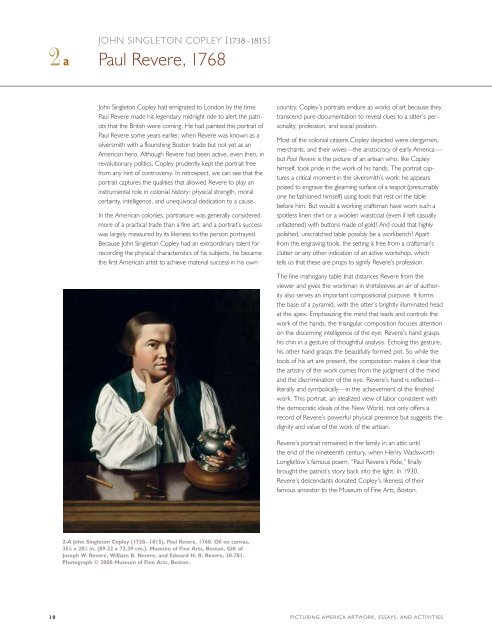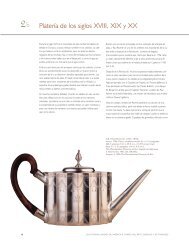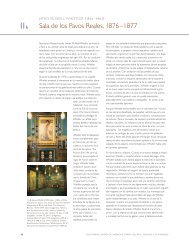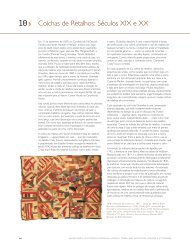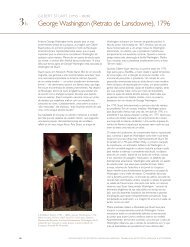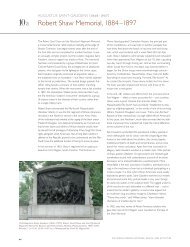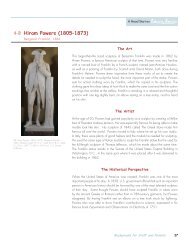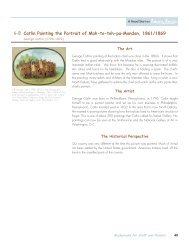Paul Revere, 1768 - Picturing America
Paul Revere, 1768 - Picturing America
Paul Revere, 1768 - Picturing America
Create successful ePaper yourself
Turn your PDF publications into a flip-book with our unique Google optimized e-Paper software.
2 a<br />
10<br />
JOHN SINGLETON COPLEY [1738–1815]<br />
<strong>Paul</strong> <strong>Revere</strong>, <strong>1768</strong><br />
John Singleton Copley had emigrated to London by the time<br />
<strong>Paul</strong> <strong>Revere</strong> made his legendary midnight ride to alert the patriots<br />
that the British were coming. He had painted this portrait of<br />
<strong>Paul</strong> <strong>Revere</strong> some years earlier, when <strong>Revere</strong> was known as a<br />
silversmith with a flourishing Boston trade but not yet as an<br />
<strong>America</strong>n hero. Although <strong>Revere</strong> had been active, even then, in<br />
revolutionary politics, Copley prudently kept the portrait free<br />
from any hint of controversy. In retrospect, we can see that the<br />
portrait captures the qualities that allowed <strong>Revere</strong> to play an<br />
instrumental role in colonial history: physical strength, moral<br />
certainty, intelligence, and unequivocal dedication to a cause.<br />
In the <strong>America</strong>n colonies, portraiture was generally considered<br />
more of a practical trade than a fine art, and a portrait’s success<br />
was largely measured by its likeness to the person portrayed.<br />
Because John Singleton Copley had an extraordinary talent for<br />
recording the physical characteristics of his subjects, he became<br />
the first <strong>America</strong>n artist to achieve material success in his own<br />
2-A John Singleton Copley (1738–1815), <strong>Paul</strong> <strong>Revere</strong>, <strong>1768</strong>. Oil on canvas,<br />
35 1 ⁄8 x 28 1 ⁄2 in. (89.22 x 72.39 cm.). Museum of Fine Arts, Boston, Gift of<br />
Joseph W. <strong>Revere</strong>, William B. <strong>Revere</strong>, and Edward H. R. <strong>Revere</strong>, 30.781.<br />
Photograph © 2008 Museum of Fine Arts, Boston.<br />
country. Copley’s portraits endure as works of art because they<br />
transcend pure documentation to reveal clues to a sitter’s personality,<br />
profession, and social position.<br />
Most of the colonial citizens Copley depicted were clergymen,<br />
merchants, and their wives—the aristocracy of early <strong>America</strong>—<br />
but <strong>Paul</strong> <strong>Revere</strong> is the picture of an artisan who, like Copley<br />
himself, took pride in the work of his hands. The portrait captures<br />
a critical moment in the silversmith’s work: he appears<br />
poised to engrave the gleaming surface of a teapot (presumably<br />
one he fashioned himself) using tools that rest on the table<br />
before him. But would a working craftsman have worn such a<br />
spotless linen shirt or a woolen waistcoat (even if left casually<br />
unfastened) with buttons made of gold? And could that highly<br />
polished, unscratched table possibly be a workbench? Apart<br />
from the engraving tools, the setting is free from a craftsman’s<br />
clutter or any other indication of an active workshop, which<br />
tells us that these are props to signify <strong>Revere</strong>’s profession.<br />
The fine mahogany table that distances <strong>Revere</strong> from the<br />
viewer and gives the workman in shirtsleeves an air of authority<br />
also serves an important compositional purpose. It forms<br />
the base of a pyramid, with the sitter’s brightly illuminated head<br />
at the apex. Emphasizing the mind that leads and controls the<br />
work of the hands, the triangular composition focuses attention<br />
on the discerning intelligence of the eye. <strong>Revere</strong>’s hand grasps<br />
his chin in a gesture of thoughtful analysis. Echoing this gesture,<br />
his other hand grasps the beautifully formed pot. So while the<br />
tools of his art are present, the composition makes it clear that<br />
the artistry of the work comes from the judgment of the mind<br />
and the discrimination of the eye. <strong>Revere</strong>’s hand is reflected—<br />
literally and symbolically—in the achievement of the finished<br />
work. This portrait, an idealized view of labor consistent with<br />
the democratic ideals of the New World, not only offers a<br />
record of <strong>Revere</strong>’s powerful physical presence but suggests the<br />
dignity and value of the work of the artisan.<br />
<strong>Revere</strong>’s portrait remained in the family in an attic until<br />
the end of the nineteenth century, when Henry Wadsworth<br />
Longfellow’s famous poem, “<strong>Paul</strong> <strong>Revere</strong>’s Ride,” finally<br />
brought the patriot’s story back into the light. In 1930,<br />
<strong>Revere</strong>’s descendants donated Copley’s likeness of their<br />
famous ancestor to the Museum of Fine Arts, Boston.<br />
PICTURING AMERICA ARTWORK, ESSAYS, AND ACTIVITIES
TEACHING ACTIVITIES<br />
E = ELEMENTARY|M = MIDDLE|S = SECONDARY<br />
DESCRIBE AND<br />
ANALYZE<br />
INTERPRET<br />
Allow students to look closely at the figure in this portrait,<br />
his environment, and what he is doing.<br />
E|M|S<br />
What is <strong>Paul</strong> <strong>Revere</strong> holding?<br />
He is holding a teapot in his left hand and his chin in his right.<br />
E|M|S<br />
Find the three engraving tools on the table. Why do you think Copley included these tools and the teapot in this portrait?<br />
They suggest that <strong>Revere</strong> was a silversmith.<br />
M|S<br />
How has Copley drawn our attention to <strong>Revere</strong>’s face?<br />
He placed <strong>Revere</strong> against a plain, dark background to contrast with his light face and shirt. The hand under his chin leads to the face.<br />
What part of the face did Copley make the most important?<br />
He made the eye on the left — <strong>Revere</strong>’s right eye — the most important.<br />
How did he do this?<br />
He accomplished this by slightly turning <strong>Revere</strong> to the viewer and shining a light on that part of <strong>Revere</strong>’s face.<br />
M|S<br />
Why did he emphasize the eye?<br />
Students can speculate on this. Perhaps he emphasized the eye to get the viewers’ attention and draw them into the painting, or<br />
perhaps to remind viewers that the eye is an important part of the artist’s skills and a sign of talent (as in “having an eye for”<br />
something), etc.<br />
E|M|S<br />
We know that some artists (such as Leonardo da Vinci) were left-handed. Ask students if they can prove whether<br />
<strong>Paul</strong> <strong>Revere</strong> worked with his right or left hand according to clues in the painting.<br />
If he is left-handed, why are the engraving tools to his right?<br />
He is not working.<br />
If he is right-handed, why does he hold the pot in the left?<br />
He rests the pot on the leather pad in order to engrave on it.<br />
M|S<br />
By placing <strong>Revere</strong>’s hand under his chin, what does Copley suggest about <strong>Revere</strong>’s personality?<br />
This pose usually indicates a thoughtful person.<br />
M|S<br />
What might the combination of these three things tell us about <strong>Paul</strong> <strong>Revere</strong> as an artist: the pot he made and prominently<br />
holds, the thoughtful gesture of the hand on chin, and the emphasis on his right eye?<br />
His work is a combination of handiwork, thought, and artistic vision.<br />
S<br />
<strong>Paul</strong> <strong>Revere</strong> was a craftsman in a busy studio. How has Copley idealized the setting for this portrait?<br />
If this were truly an artist’s workbench, it would probably be littered with tools and bits of metal.<br />
CONNECTIONS History Connections: Sons of<br />
Liberty; Boston Tea Party; <strong>Paul</strong><br />
<strong>Revere</strong>’s famous ride and ensuing<br />
battles in Lexington and Concord<br />
(<strong>America</strong>n Revolution)<br />
Historical Figures: <strong>Paul</strong> <strong>Revere</strong>;<br />
King George III; Patrick Henry;<br />
John Adams; Samuel Adams;<br />
Crispus Attucks<br />
Civics: Whigs v. Tories<br />
Geography: Massachusetts Bay;<br />
Charles River; Coastal Lowlands<br />
Literary Connections and Primary<br />
Documents: Common Sense, Thomas<br />
Paine (secondary); Rip Van Winkle<br />
and The Legend of Sleepy Hollow,<br />
Washington Irving (elementary);<br />
“<strong>Paul</strong> <strong>Revere</strong>’s Ride,” Henry<br />
Wadsworth Longfellow (elementary)<br />
Arts: portraiture; <strong>America</strong>n<br />
colonial art<br />
PAUL REVERE, <strong>1768</strong>, JOHN SINGLETON COPLEY [1738–1815] 11<br />
teaching activities


